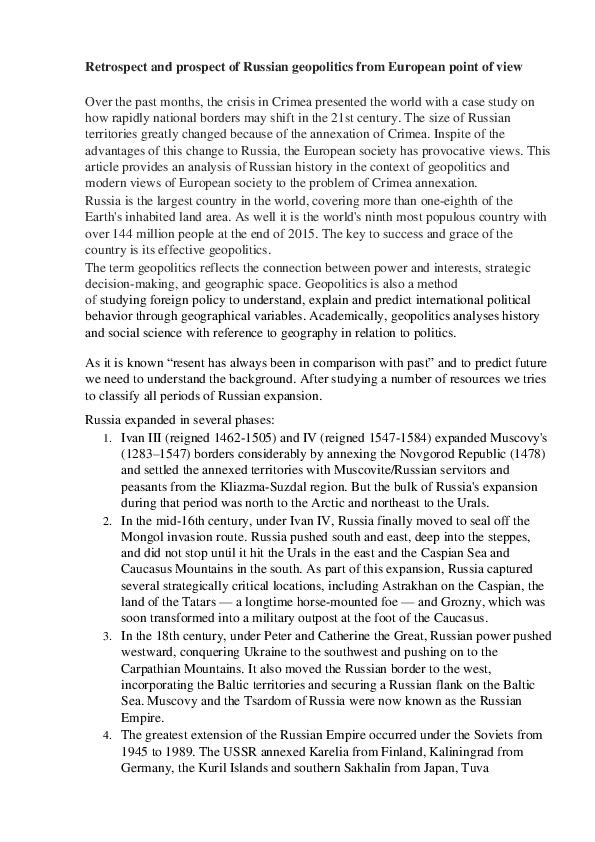Retrospect and prospect of Russian geopolitics from European point of view
Over the past months, the crisis in Crimea presented the world with a case study on
how rapidly national borders may shift in the 21st century. The size of Russian
territories greatly changed because of the annexation of Crimea. Inspite of the
advantages of this change to Russia, the European society has provocative views. This
article provides an analysis of Russian history in the context of geopolitics and
modern views of European society to the problem of Crimea annexation.
Russia is the largest country in the world, covering more than oneeighth of the
Earth's inhabited land area. As well it is the world's ninth most populous country with
over 144 million people at the end of 2015. The key to success and grace of the
country is its effective geopolitics.
The term geopolitics reflects the connection between power and interests, strategic
decisionmaking, and geographic space. Geopolitics is also a method
of studying foreign policy to understand, explain and predict international political
behavior through geographical variables. Academically, geopolitics analyses history
and social science with reference to geography in relation to politics.
As it is known “resent has always been in comparison with past” and to predict future
we need to understand the background. After studying a number of resources we tries
to classify all periods of Russian expansion.
Russia expanded in several phases:
1.
2.
3.
Ivan III (reigned 14621505) and IV (reigned 15471584) expanded Muscovy's
(1283–1547) borders considerably by annexing the Novgorod Republic (1478)
and settled the annexed territories with Muscovite/Russian servitors and
peasants from the KliazmaSuzdal region. But the bulk of Russia's expansion
during that period was north to the Arctic and northeast to the Urals.
In the mid16th century, under Ivan IV, Russia finally moved to seal off the
Mongol invasion route. Russia pushed south and east, deep into the steppes,
and did not stop until it hit the Urals in the east and the Caspian Sea and
Caucasus Mountains in the south. As part of this expansion, Russia captured
several strategically critical locations, including Astrakhan on the Caspian, the
land of the Tatars — a longtime horsemounted foe — and Grozny, which was
soon transformed into a military outpost at the foot of the Caucasus.
In the 18th century, under Peter and Catherine the Great, Russian power pushed
westward, conquering Ukraine to the southwest and pushing on to the
Carpathian Mountains. It also moved the Russian border to the west,
incorporating the Baltic territories and securing a Russian flank on the Baltic
Sea. Muscovy and the Tsardom of Russia were now known as the Russian
Empire.
4. The greatest extension of the Russian Empire occurred under the Soviets from
1945 to 1989. The USSR annexed Karelia from Finland, Kaliningrad from
Germany, the Kuril Islands and southern Sakhalin from Japan, Tuva(previously governed by Mongolia and Manchu Empire) etc. In addition the
ground was prepared for postSoviet semicolonial adventures in Transnestria,
Abkhazia and South Ossetia. Even the continuing basis provided by Nagorno
Karabakh for interference by Russia in the internal affairs of Armenia and
Azerbaijan hark back to the USSR's policies and activities.
In modern world countries very rarely change their borders, that is why the
annexation of Crimea got much publicity.
The internationally recognised Ukrainian territory of Crimea was annexed by the
Russian Federation on 18 March 2014. From the time of the annexation, Russia has de
facto administered the peninsula as two federal subjects—the Republic of Crimea and
the city of Sevastopol—within the Crimean Federal District. The military intervention
and annexation by Russia took place in the aftermath of the Ukrainian Revolution and
was part of wider unrest across southern and eastern Ukraine.
Although Russia did its best to rescue people in Crimea, European society has very
controversial views and reactions.


